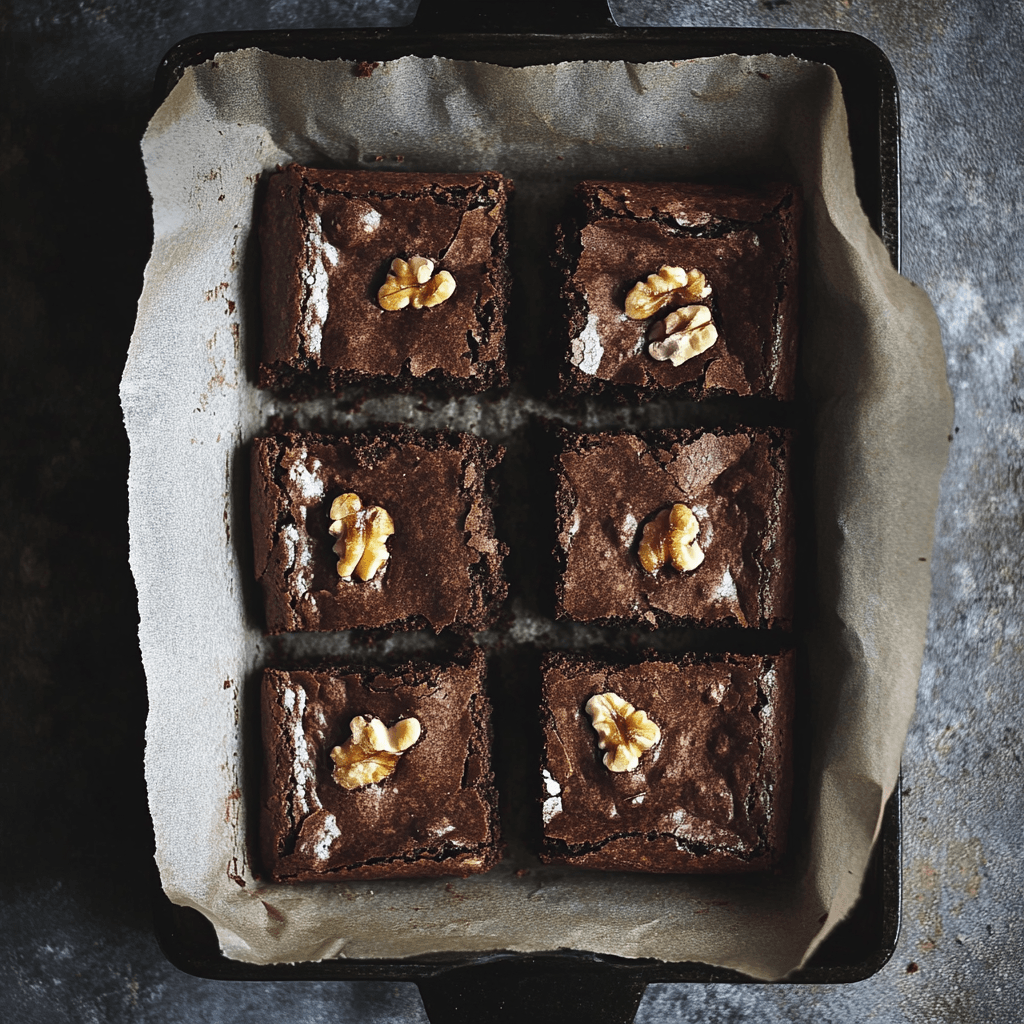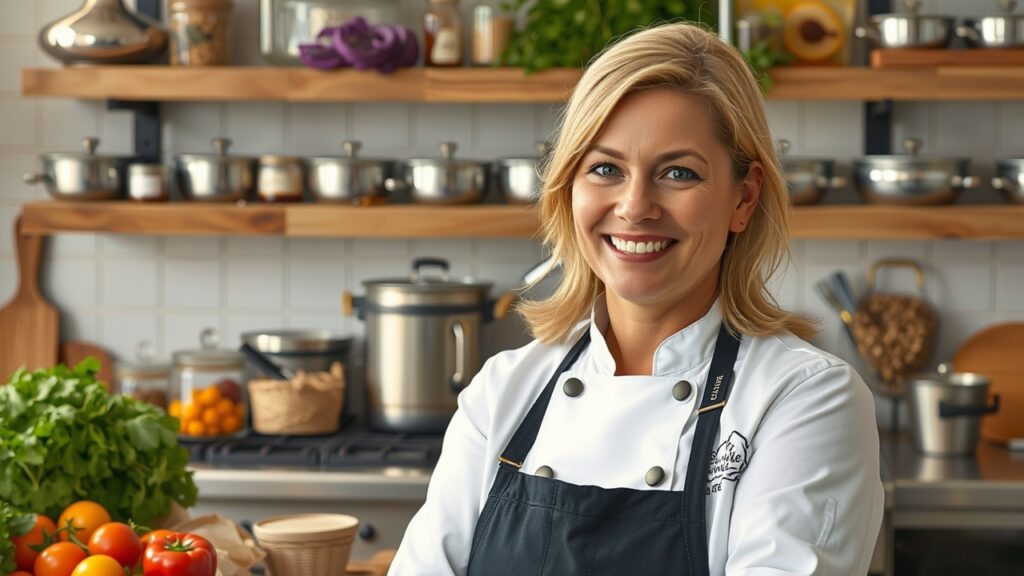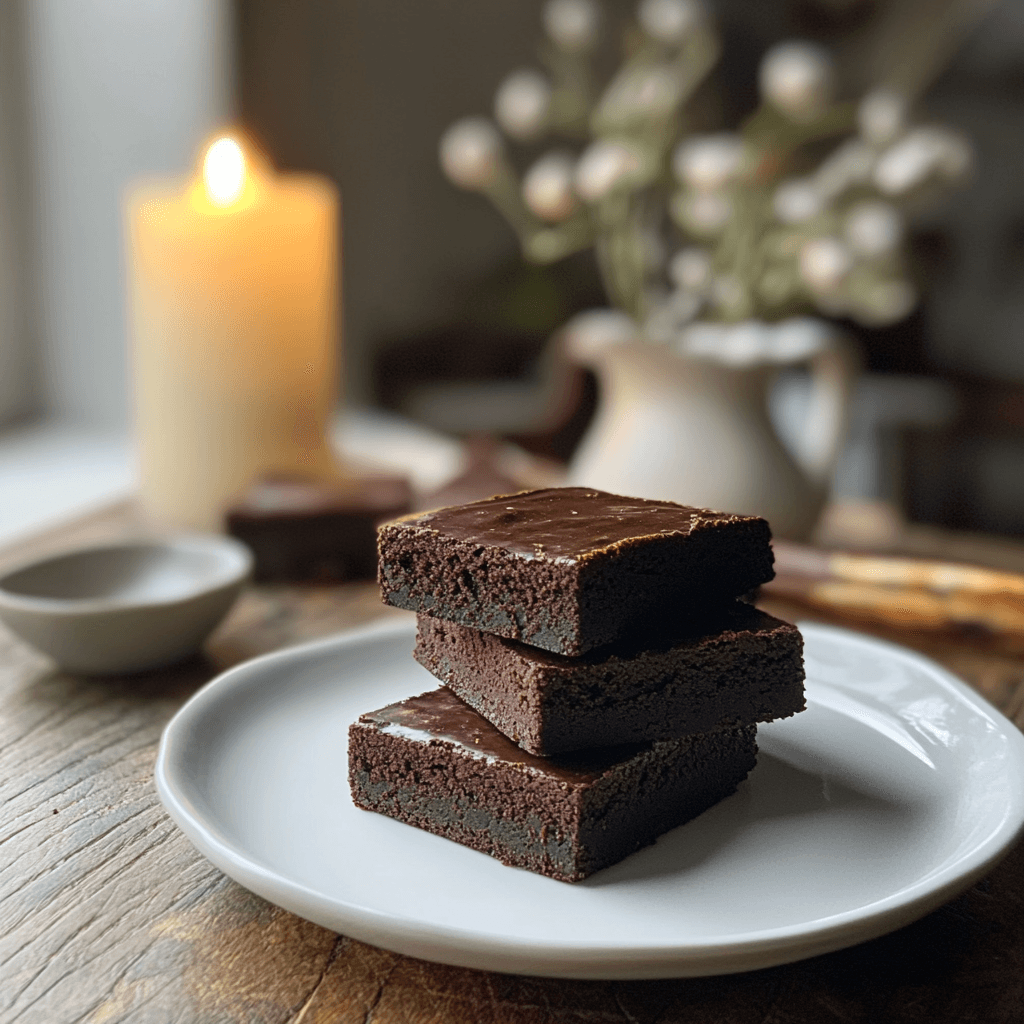Introduction to Simple Dark Chocolate Brownies
If you’re a true chocolate lover, there’s nothing quite as satisfying as a rich, dark chocolate brownie. With their deep cocoa flavor, slightly crisp top, and dense, fudgy center, these brownies are the definition of indulgence. And the best part? They’re incredibly easy to make—no fancy equipment, no complicated steps, just pure chocolate bliss.
Why Dark Chocolate Makes Better Brownies
Dark chocolate delivers a bold, intense flavor that milk chocolate just can’t match. It gives brownies a richer, more complex taste while keeping the sweetness balanced. Plus, dark chocolate contains less sugar and more cocoa solids, which creates that deep, almost bittersweet edge that elevates every bite.
Perfect for Beginners and Pros Alike
This recipe is ideal for anyone—from first-time bakers to seasoned pros. It uses simple ingredients, requires just one bowl, and delivers consistently amazing results. Whether you’re baking for a dinner party, holiday celebration, or a late-night craving, these dark chocolate brownies are guaranteed to impress.
Benefits of Using Dark Chocolate in Brownies
Dark chocolate isn’t just a delicious upgrade—it also brings several advantages when used in brownie recipes. Here’s why it’s worth choosing dark over milk or overly sweetened chocolate.
Richer Flavor
Dark chocolate delivers a deeper, more complex flavor profile, enhancing the overall richness of your brownies. Its intense cocoa taste pairs beautifully with butter and sugar, creating that perfect balance of bitter and sweet without being overwhelming.
Lower Sugar Content
Compared to milk chocolate, dark chocolate contains significantly less sugar. This helps you control the overall sweetness of your brownies, giving you the flexibility to add other sweet elements like frosting, fruit, or mix-ins without making the dessert overly sugary.
Healthier Antioxidants
Dark chocolate is also rich in flavonoids and antioxidants, which are known to support heart health and reduce inflammation. While brownies aren’t exactly health food, using quality dark chocolate makes them a slightly more wholesome indulgence—without sacrificing flavor.
Choosing the Best Dark Chocolate
The type of dark chocolate you use can make or break your brownies. Whether you’re shopping at the grocery store or online, understanding cocoa content and chocolate style helps you bake with confidence.
Bittersweet vs Semisweet
- Bittersweet chocolate: Contains around 70% cacao or more. It has a bolder, more intense chocolate flavor and less sugar—ideal for those who prefer a less sweet brownie.
- Semisweet chocolate: Usually ranges from 50–65% cacao and strikes a sweeter balance. Still rich, but more accessible to those who like a hint of sweetness.
Both types work well—choose based on your preferred taste and the overall sweetness level of your recipe.
Recommended Cocoa Percentage
- For a deep, rich taste, look for dark chocolate with 60–75% cacao.
- If you’re using unsweetened cocoa powder alongside it, a slightly sweeter chocolate (like 60–65%) helps maintain balance.
- Going above 80%? Be aware: it may turn out too bitter for general audiences unless counterbalanced with sugar or sweet mix-ins.
Top Brands to Try
- Ghirardelli – Widely available, consistent quality, great for baking.
- Lindt – Smooth, balanced bittersweet chocolate with gourmet feel.
- Valrhona – A premium brand for bold, nuanced dark chocolate flavor.
- Guittard – Known for high-quality baking bars and chips with excellent meltability.
- Scharffen Berger – Ideal for rich, refined chocolate flavor with artisanal flair.
Key Ingredients for Simple Dark Chocolate Brownies
Great brownies start with simple, quality ingredients. You don’t need anything fancy—just the right combination of pantry staples and a little attention to detail.
Pantry Staples
- All-purpose flour – Just enough to provide structure without making the brownies cakey.
- Granulated sugar – Helps create the signature crackly top and balances the bitterness of dark chocolate.
- Unsweetened cocoa powder – Adds depth and reinforces the dark chocolate flavor.
- Salt – A pinch enhances sweetness and boosts the chocolate notes.
- Vanilla extract – Rounds out the flavor with subtle warmth and richness.
Importance of Quality Butter, Sugar, and Eggs
- Butter: Use unsalted, high-quality butter for a smooth, rich texture. Real butter adds depth that margarine or oil can’t match.
- Eggs: Eggs contribute to structure and moisture. Large, room-temperature eggs work best.
- Sugar: For best results, use pure cane sugar—it dissolves more evenly and caramelizes slightly during baking, enhancing flavor.
Pro Tip: Always bring your eggs and butter to room temperature before baking. It helps the batter mix evenly and bakes more consistently.
Tools You Need to Make Perfect Brownies
You don’t need a high-end kitchen to make incredible brownies—but a few key tools will make the process easier and more precise.
Basic Baking Tools
- 8×8 or 9×9-inch square pan – Ideal for thick, fudgy brownies.
- Mixing bowls – One large for wet ingredients, one medium for dry.
- Rubber spatula – Perfect for folding and scraping every bit of batter.
- Whisk or wooden spoon – For mixing by hand (a hand mixer is optional).
- Parchment paper – Prevents sticking and makes it easy to lift brownies out for clean cuts.
Optional Equipment for Precision
- Kitchen scale – Ensures accurate flour and sugar measurements.
- Toothpick or cake tester – Helps check doneness without cutting into the brownies.
- Offset spatula – Smooths the batter evenly in the pan before baking.
- Cooling rack – Prevents soggy bottoms by allowing air to circulate after baking.
Even with just the basics, you can make brownies that rival any bakery. But having the right tools on hand makes the process smoother—and the results more consistent.
Step-by-Step Simple Dark Chocolate Brownie Recipe
This no-fuss brownie recipe delivers big on flavor with minimal effort. You’ll get rich, dark chocolate brownies that are perfectly chewy with a soft, fudgy center.
Full Recipe Instructions
Ingredients:
- 1/2 cup (1 stick) unsalted butter
- 1 cup granulated sugar
- 2 large eggs
- 1 tsp vanilla extract
- 1/3 cup unsweetened cocoa powder
- 1/2 cup all-purpose flour
- 1/4 tsp salt
- 3 oz dark chocolate (60–70% cacao), chopped or chips (optional)
Instructions:
- Preheat oven to 325°F (163°C). Line an 8×8-inch baking pan with parchment paper or grease lightly.
- Melt the butter in a medium bowl. While still warm, stir in the sugar, vanilla, and cocoa powder.
- Add eggs one at a time, beating well after each addition until glossy and thick.
- In a separate bowl, whisk together flour and salt. Fold into the wet mixture just until combined.
- Fold in dark chocolate chunks or chips if using.
- Spread batter evenly in the prepared pan.
Baking Tips
- Don’t overmix once the flour is added—this keeps your brownies tender.
- Bake for 22–28 minutes, or until a toothpick inserted near the center comes out with moist crumbs (not wet batter).
- Use an oven thermometer if you can—baking temperature matters for perfect texture.
Cooling and Slicing
- Let brownies cool in the pan for at least 15 minutes before lifting out.
- Cool fully on a wire rack for clean, even slices.
- Use a sharp knife and wipe between cuts for bakery-style presentation.
Customizing Your Brownies
Simple dark chocolate brownies are a perfect base for endless variations. Whether you’re adding texture, adjusting for dietary needs, or turning up the flavor, these custom ideas will help you make them your own.
Adding Nuts, Fruits, or Spices
- Nuts: Add 1/2 cup chopped walnuts, pecans, or almonds for crunch.
- Dried fruits: Mix in dried cherries, cranberries, or orange zest for a sweet-tart contrast.
- Spices: A pinch of cinnamon, chili powder, or espresso powder can intensify the chocolate and add complexity.
Making It Gluten-Free or Dairy-Free
- Gluten-free: Use a 1:1 gluten-free flour blend (like Bob’s Red Mill or King Arthur). Almond flour can also work, but may change the texture.
- Dairy-free:
- Swap butter with coconut oil or vegan butter.
- Use dairy-free chocolate chips (like Enjoy Life or Hu Kitchen).
- The rest of the recipe stays the same—just watch baking time, as some adjustments may affect moisture.
Pro tip: Always test small batches when making dietary substitutions to fine-tune texture and taste.
How to Achieve Fudgy vs Cakey Texture
One of the best things about homemade brownies is your ability to control the texture. Whether you’re team fudgy or team cakey, small adjustments in the recipe can make a big difference.
Adjusting Fat, Flour, and Eggs
- Fudgy brownies:
- Use more fat (butter or chocolate) and less flour.
- Stick with 2 eggs and avoid leavening agents like baking powder.
- Melted chocolate or added cocoa increases richness and chewiness.
- Cakey brownies:
- Add a bit more flour and an extra egg.
- Include baking powder (1/4 tsp) for lift and a lighter texture.
- Beat the eggs and sugar longer for an airier batter.
Tips for Texture Control
- Don’t overmix once flour is added—this affects gluten development and can toughen brownies.
- Bake in metal pans for crisper edges; glass pans often lead to overbaked centers.
- Test early: A toothpick with moist crumbs (not wet batter) signals fudgy perfection. For cakey brownies, wait until it comes out nearly clean.
Mistakes to Avoid When Making Dark Chocolate Brownies
Even simple recipes have their pitfalls. Avoid these common mistakes to make sure your brownies turn out rich, moist, and perfectly balanced.
Overbaking
- Brownies continue to cook slightly after you take them out.
- Overbaking = dry, crumbly texture and bitter chocolate flavor.
- Start checking a few minutes early and pull them when the center is just set.
Wrong Chocolate Ratio
- Too much cocoa powder and not enough fat or sugar can result in a chalky, bitter texture.
- Use high-quality dark chocolate (60–70% cacao) in balance with sugar and butter.
- If substituting cocoa for chocolate, add extra fat to compensate.
Improper Mixing Technique
- Overmixing can lead to tough or rubbery brownies, especially after adding flour.
- Under-mixing melted butter, sugar, and eggs can leave your batter grainy or uneven.
- Whisk wet ingredients thoroughly, then gently fold in dry ingredients until just combined.
Pro tip: Use a rubber spatula to fold instead of a whisk—it helps control overmixing and keeps the texture dense and smooth.
Storage and Freezing Tips
Homemade dark chocolate brownies are just as delightful days later—if stored properly. Here’s how to keep them fresh, freezer-friendly, and ready for reheating when a craving strikes.
Keeping Brownies Fresh
- Room temperature: Store brownies in an airtight container for up to 4 days.
- Layer with parchment paper if stacking, to avoid sticking.
- Add a slice of bread in the container to help maintain moisture.
Freezing in Portions
- Brownies freeze exceptionally well—perfect for portion control or make-ahead treats.
- Wrap individual squares tightly in plastic wrap, then place in a freezer-safe bag.
- Freeze for up to 3 months.
Pro tip: Label your freezer bag with the date and reheating instructions!
Reheating for Gooey Texture
- Microwave: Warm a brownie for 10–15 seconds for a gooey, just-baked center.
- Oven: Preheat to 300°F (150°C) and warm for 8–10 minutes, especially if reheating multiple servings.
Optional: Add a scoop of ice cream after warming for an ultra-decadent dessert.
Serving Suggestions for Maximum Enjoyment
Brownies are versatile—serve them simply or turn them into something extra special. These ideas help you enjoy them to the fullest.
With Ice Cream
- The classic pairing: warm brownie + cold vanilla ice cream = heaven.
- Try it with other flavors like salted caramel, espresso, or cherry vanilla for fun twists.
As a Base for Sundaes
- Stack your brownie with ice cream, whipped cream, chocolate sauce, and a cherry for a DIY brownie sundae.
- Add crushed nuts, toffee bits, or a drizzle of warm peanut butter for extra flair.
Paired with Coffee or Wine
- Dark roast coffee brings out the richness of the chocolate.
- Red wines like Cabernet Sauvignon, Zinfandel, or a Ruby Port pair beautifully with fudgy brownies.
- For a cozy night in, serve with a cappuccino and a dusting of powdered sugar.
Dark Chocolate Brownies for Special Diets
Brownies are for everyone—and with a few smart ingredient swaps, you can make these rich treats accessible to a variety of dietary needs without sacrificing taste or texture.
Low-Sugar Adaptations
- Use dark chocolate with 70–85% cacao, which contains less sugar than semisweet or milk chocolate.
- Substitute part or all of the sugar with alternatives like:
- Coconut sugar for a natural, lower-glycemic option.
- Monk fruit sweetener or erythritol for sugar-free versions.
- Be sure to taste the batter, as some substitutes can be less sweet or slightly bitter.
Vegan Versions
- Butter substitute: Use coconut oil or vegan butter (like Earth Balance or Miyoko’s).
- Egg substitute: Use flax eggs (1 tbsp ground flax + 3 tbsp water per egg) or a store-bought egg replacer.
- Choose dairy-free dark chocolate chips (e.g., Enjoy Life or Hu Kitchen).
These changes work best in fudgy-style brownies rather than cakey ones, as vegan recipes often result in denser textures.
Nut-Free and Allergy-Friendly Tweaks
- Skip nuts entirely, or use seeds (like pumpkin or sunflower) for crunch without allergens.
- Always use allergy-safe chocolate (check for “nut-free” labeling).
- For gluten allergies, substitute with a 1:1 gluten-free flour blend.
Tip: Always double-check ingredient labels if baking for someone with allergies or dietary restrictions.
Frequently Asked Questions About Simple Dark Chocolate Brownies
What cocoa percentage is best?
For rich, balanced brownies, aim for dark chocolate between 60–70% cacao. This level provides bold flavor without becoming too bitter. If you’re using unsweetened cocoa in combination, 65–70% chocolate offers the best pairing.
Can I use cocoa powder instead?
Yes! Cocoa powder can be used in place of melted chocolate, but you’ll need to:
- Increase the butter slightly to account for lost fat.
- Use unsweetened cocoa for best results—preferably Dutch-processed for a smoother taste.
Use about 1/3 cup cocoa powder per 3 oz of dark chocolate as a general rule.
Why are my brownies crumbly?
Crumbly brownies can result from:
- Overbaking – the #1 culprit of dry or crumbly texture.
- Too much flour – especially if measured by volume instead of weight.
- Not enough fat or eggs – which are key to moisture and binding.
Pro tip: Use a kitchen scale and avoid overmixing or overbaking to keep brownies soft and fudgy.
If you’re craving more chocolate goodness, don’t miss the Better-Than-Box-Mix Brownies for a deeper dive into homemade indulgence. Prefer something quick and cool? These Chocolate Peanut Butter No-Bake Cookies are perfect for satisfying your sweet tooth without turning on the oven. For a cake-based dessert that’s equally rich and impressive, try The Perfect German Chocolate Cake Recipe—a layered delight any chocolate fan will love.
Suggested placement:
For premium quality and deep cocoa flavor, consider using Guittard’s baking chocolate, a favorite among professional and home bakers alike.
Conclusion: Simple Dark Chocolate Brownies That Wow Every Time
Rich, easy, and endlessly customizable, these simple dark chocolate brownies prove that you don’t need a complicated recipe to make an unforgettable dessert. With just a few quality ingredients and a single bowl, you can create brownies that are bold in flavor, perfectly fudgy, and guaranteed to impress every time.
Whether you’re a first-time baker or a seasoned pro, this no-fail recipe is one you’ll return to again and again. So preheat your oven, grab your favorite dark chocolate, and get ready to bake brownies that deliver pure chocolate joy in every bite.






